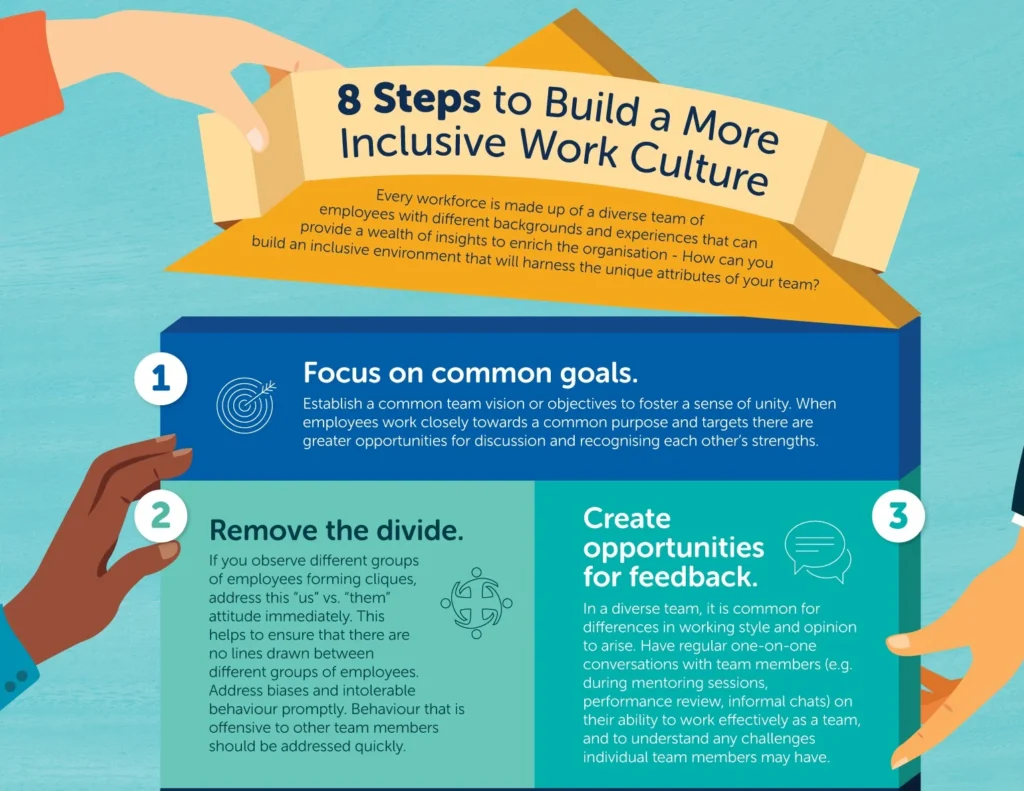Building a diverse and inclusive workplace is crucial for the success of any organization. **Creating an environment where people of all backgrounds feel valued and included** is not only the right thing to do, but it also leads to **increased innovation, better decision-making, and a more positive work culture**. To achieve this, companies can implement **diversity training programs, establish inclusive policies and practices, and actively recruit and retain a diverse workforce**. Additionally, fostering open communication and providing support for underrepresented groups are essential steps in **building a diverse and inclusive workplace**.
In order to cultivate a work environment that embraces differences and promotes equality, it is important to consider alternative approaches to **promoting diversity and inclusion**. **This may include implementing mentorship programs for underrepresented employees, creating affinity groups where individuals can connect over shared experiences, and ensuring that diversity and inclusion are integrated into all aspects of the company’s operations**. By prioritizing **diversity and inclusion**, organizations can create a more welcoming and empowering workplace for all employees, ultimately leading to greater success and satisfaction.
Understanding Diversity and Inclusion
Diversity in the workplace refers to the variety of different attributes, backgrounds, and perspectives among employees. This can include differences in race, ethnicity, gender, age, sexual orientation, disability, religion, and more. Inclusion, on the other hand, is the practice of ensuring that all employees feel valued, respected, and included in the workplace, regardless of their differences. It involves creating a sense of belonging and providing equal opportunities for all individuals.
Building a diverse and inclusive workplace is essential for fostering innovation, creativity, and a positive work environment. It can also lead to better decision-making and problem-solving, as diverse teams bring a wider range of perspectives to the table. Ultimately, creating a workplace where diversity is celebrated and inclusion is prioritized can lead to higher employee satisfaction and retention.
Creating a Culture of Diversity and Inclusion
Creating a culture of diversity and inclusion starts with leadership commitment and accountability. Leaders must set the tone for the organization by clearly communicating the importance of diversity and inclusion and leading by example. This can involve implementing diversity and inclusion training programs, establishing diversity goals and metrics, and holding leaders accountable for creating an inclusive environment.
It’s also important to actively involve employees in the process of building a diverse and inclusive workplace. This can include seeking input from employees from diverse backgrounds, creating employee resource groups, and providing opportunities for open and honest discussions about diversity and inclusion. By involving employees in the process, organizations can ensure that their efforts are truly reflective of the needs and experiences of their workforce.
Recruiting and Hiring for Diversity
Recruiting and hiring for diversity involves implementing strategies to attract and retain a diverse talent pool. This can include reviewing and revising job descriptions to remove any biased language, expanding recruiting efforts to target diverse candidate pools, and using diverse interview panels to reduce bias in the hiring process. Additionally, organizations can implement diversity-focused recruitment initiatives, such as partnerships with diverse professional organizations and outreach to diverse colleges and universities.
It’s also important for organizations to prioritize diversity and inclusion in their onboarding and training processes. This can involve providing diversity and inclusion training for new hires, ensuring that all employees are aware of the organization’s commitment to diversity and inclusion, and setting clear expectations for inclusive behavior from the start of an employee’s tenure.
Providing Equal Opportunities and Advancement
Providing equal opportunities and advancement for all employees is crucial for creating a diverse and inclusive workplace. This involves ensuring that all employees have access to the same opportunities for development, advancement, and recognition, regardless of their background or identity. Organizations can achieve this by implementing transparent promotion and advancement processes, offering mentorship and sponsorship programs for employees from underrepresented groups, and providing equal access to training and development opportunities.
It’s also important for organizations to regularly review their policies and practices to identify and address any potential barriers to equal opportunities and advancement. This can involve conducting pay equity audits, analyzing promotion and advancement data by demographic group, and actively addressing any disparities that are identified. By continuously monitoring and addressing issues related to equal opportunities, organizations can create a more equitable and inclusive workplace.
Fostering Inclusive Leadership
Fostering inclusive leadership involves empowering leaders to create and maintain inclusive environments within their teams. This can include providing leadership development programs that focus on diversity and inclusion, offering coaching and feedback to help leaders recognize and address their own biases, and holding leaders accountable for creating inclusive teams. It’s also important for organizations to ensure that their leadership ranks reflect diversity, as diverse leadership can serve as role models and advocates for inclusive practices.
Inclusive leaders are those who actively seek out and value different perspectives, create a sense of belonging for all team members, and advocate for the needs of underrepresented groups. By fostering inclusive leadership, organizations can create a ripple effect throughout the entire workforce, as inclusive leaders serve as champions for diversity and inclusion within their teams and across the organization.
Implementing Diversity and Inclusion Training
Implementing diversity and inclusion training is an essential component of building a diverse and inclusive workplace. This involves providing all employees with the knowledge and skills to understand and address unconscious bias, communicate effectively across differences, and create an inclusive work environment. Training can cover a range of topics, including cultural competence, inclusive language, and strategies for creating diverse and inclusive teams.
It’s important for organizations to ensure that diversity and inclusion training is ongoing and integrated into the broader employee development strategy. This can involve offering regular training sessions, providing resources for self-directed learning, and incorporating diversity and inclusion into performance management processes. By making diversity and inclusion training a priority, organizations can ensure that all employees are equipped to contribute to a diverse and inclusive workplace.
Celebrating Diversity and Inclusion
Celebrating diversity and inclusion involves recognizing and honoring the unique backgrounds, perspectives, and contributions of all employees. This can include hosting events and activities that highlight different cultures, traditions, and identities, showcasing the achievements of diverse employees, and creating opportunities for employees to share their experiences and perspectives. By celebrating diversity and inclusion, organizations can create a sense of belonging and appreciation for all individuals within the workplace.
It’s important for organizations to involve employees in the planning and execution of diversity and inclusion celebrations, ensuring that the events are reflective of the diverse experiences within the workforce. By creating opportunities for employees to share their stories and traditions, organizations can foster understanding and connection among employees from different backgrounds, ultimately strengthening the overall workplace culture.
Measuring and Evaluating Diversity and Inclusion Efforts
Measuring and evaluating diversity and inclusion efforts is essential for understanding the impact of initiatives and identifying areas for improvement. Organizations can measure diversity and inclusion through a variety of methods, including employee surveys, demographic data analysis, and tracking key performance indicators related to diversity and inclusion. By regularly collecting and analyzing data, organizations can gain insights into the effectiveness of their efforts and make informed decisions about future strategies.
It’s important for organizations to set specific, measurable, and achievable goals related to diversity and inclusion, and to regularly track progress towards these goals. Additionally, organizations can leverage external benchmarks and best practices to assess their performance and identify opportunities for growth. By prioritizing measurement and evaluation, organizations can ensure that their diversity and inclusion efforts are impactful and aligned with the needs of their workforce.
Steps to Build a Diverse and Inclusive Workplace
| Step | Description |
|---|---|
| 1 | Understand the importance of diversity and inclusion |
| 2 | Evaluate current workplace demographics and culture |
| 3 | Implement inclusive hiring practices |
| 4 | Provide diversity and inclusion training for employees |
| 5 | Create support systems for underrepresented groups |
| 6 | Promote diversity and inclusion in company policies and practices |
| 7 | Regularly assess and adjust diversity and inclusion efforts |
Building a diverse and inclusive workplace requires a deliberate and ongoing effort to understand the importance of diversity, evaluate current practices, and implement strategies to promote inclusivity. By creating a supportive and diverse environment, companies can benefit from a wider range of perspectives and experiences, leading to innovation and success.



